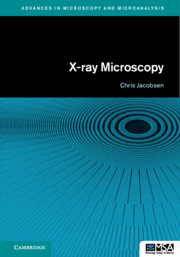Book contents
- Frontmatter
- Contents
- Contributors page
- Foreword
- 1 X-Ray Microscopes: a Short Introduction
- 2 A Bit of History
- 3 X-Ray Physics
- 4 Imaging Physics
- 5 X-Ray Focusing Optics
- 6 X-Ray Microscope Systems
- 7 X-Ray Microscope Instrumentation
- 8 X-Ray Tomography
- 9 X-Ray Spectromicroscopy
- 10 Coherent Imaging
- 11 Radiation Damage and Cryo Microscopy
- 12 Applications, and Future Prospects
- Appendix A X-Ray Data Tabulations
- References
- Index
8 - X-Ray Tomography
Published online by Cambridge University Press: 28 October 2019
- Frontmatter
- Contents
- Contributors page
- Foreword
- 1 X-Ray Microscopes: a Short Introduction
- 2 A Bit of History
- 3 X-Ray Physics
- 4 Imaging Physics
- 5 X-Ray Focusing Optics
- 6 X-Ray Microscope Systems
- 7 X-Ray Microscope Instrumentation
- 8 X-Ray Tomography
- 9 X-Ray Spectromicroscopy
- 10 Coherent Imaging
- 11 Radiation Damage and Cryo Microscopy
- 12 Applications, and Future Prospects
- Appendix A X-Ray Data Tabulations
- References
- Index
Summary
Doğa Gürsoy contributed to this chapter.
Up until now we have concentrated on two-dimensional (2D) imaging of thin specimens. However, one of the advantages microscopy with X rays offers is great penetrating power. This means that X rays can image much thicker specimens than is possible in, for example, electron microscopy (as discussed in Section 4.10). For this reason, tomography (where one obtains 3D views of 3D objects) plays an important role in x-ray microscopy. There are entire books written on how tomography works [Herman 1980, Kak 1988], and on its application to x-ray microscopy [Stock 2008], so our treatment here will be limited to the essentials. Examples of transmission tomography images are shown in Figs. 12.1, 12.6, and 12.9, while fluorescence tomography is shown in Fig. 12.3.
Our discussion of x-ray tomography will be carried out using several simplifying assumptions:
• We will assume parallel illumination, even though there are reconstruction algorithms [Tuy 1983, Feldkamp 1984] for cone beam tomography where the beam diverges from a point source.
• We will assume that we start with images that provide a linear response to the projected object thickness t(x, y) along each viewing direction. In the case of absorption contrast transmission imaging, this can be done by calculating the optical density D(x, y) = - ln[I(x, y)/I0] = μt(x, y) as given by Eq. 3.83, with μ being the material's linear absorption coefficient (LAC) of Eq. 3.75. In phase contrast imaging, one may have to use phase unwrapping [Goldstein 1988, Volkov 2003] methods to first obtain a projection image which is linear with the projected object thickness since (see Fig. 3.17).
• We will assume that there is no spatial-frequency-dependent reduction in the contrast of image features as seen in a projection image. That is, we will assume that the modulation transfer function (MTF) is 1 at all frequencies u (see Section 4.4.7). One can always approach this condition by doing deconvolution (Section 4.4.8) on individual projection images before tomographic reconstruction, or building in an actual MTF estimate into optimization approaches (Section 8.2.1).
• We will assume that the first Born approximation applies (Section 3.3.4): we can approximate the wavefield that reaches a downstream plane in a 3D object as being essentially the same as the wavefield reaching an upstream plane.
- Type
- Chapter
- Information
- X-ray Microscopy , pp. 321 - 349Publisher: Cambridge University PressPrint publication year: 2019
- 1
- Cited by



